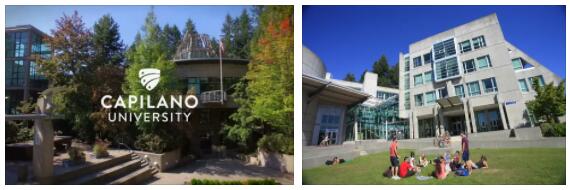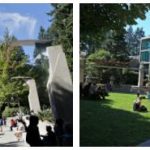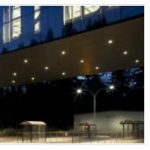Preparation and application process
You should start early enough to plan your semester abroad. About a year in advance, I made my first thoughts, read field reports and started planning actively from January 2018.
With the help of the free MicroEDU organization, I organized my stay at the beginning of January 2018. My supervisor at MicroEDU was always easy to reach and answered questions about the application process at any time. Many Thanks!
The following documents were required for the application:
- Application forms and preliminary course preselection for Capilano University
(These were ready- made documents that we received from Capilano University via MicroEDU.) - Proof of English (TOEFL 83 iBT, DAAD B2, IELTS 6.5, PTE 56)
- Transcript of Records
- Confirmation letter (official, in English) from the home university that it approves the stay.
For the application, I sent the original of these documents for a second review to my contact at MicroEDU, who then forwarded them to Capilano University. In general, MicroEDU has always taken over the contact and exchange with Capilano, so that I personally never had to write to Capilano.
Two months after submitting the application, I received the Letter of Offer (LoO). In order to be able to accept the offer, I had to pay the first part of my tuition fees. All payment transactions to the university were made using my credit card. You should therefore inquire beforehand whether the availability limit is sufficient for this. For on-site payments abroad, I can recommend the DKB credit card, which you can use to pay for free.
After payment, I unfortunately received the letter of acceptance a little late, which finally confirmed my admission. With this confirmation I was able to register for the whole system (email, account, Moodle) and choose my courses in the portal. After registering, I specifically took care of flights and accommodation.
Tip: I booked my flights relatively early through STA Travel with a student discount and was able to save a lot of money.
visa
For Canada you don’t need a visa if you stay up to 6 months and if you don’t want to go to work. That saved me a lot of effort and time. Since Germany is one of the visa-ready countries for Canada, I only had to apply for the so-called “Electronic Travel Authorization” (eTA) online. This allowed me to enter Canada by air. I received confirmation of this within 48 hours.
Health insurance
As an international student at Capilano University, you are obliged to use the university’s health insurance. The insurance is taken out automatically and is valid for the duration of the semester. Since the benefits of the Canadian insurance were not enough for me personally, because they did not sufficiently cover many incidents in my opinion and I also needed protection before and after the semester through my trips, I also have a German international health insurance with the Würzburger Versicherung for the Stay complete.
Foreign university
Capilano University has 11,600 students and five programs to study in. Its main campus is in the green part of North Vancouver and is roughly comparable to the size of the Ostfalia University in Wolfsburg. Thanks to the small and familiar atmosphere, you get to know other students much faster and you see one or the other face on campus more often. In addition to the lecture rooms, the area offers a free Center of Sport and Wellness with a fitness studio and a sports hall, a cafeteria, two Tim Hortons, Subway and a large library.
With over 1900 international students from 73 countries around the world, Capilano has a very international focus. The International Office is always available for questions and organizes events such as a Christmas dinner to create connections between the international students. There is also a Writing Center to help with drafting and reviewing English texts.
With around 25 participants per course, the courses are relatively small. This resulted in a very personal and intensive working atmosphere with the lecturer and the other students.
The university system in Canada in general and also at Capilano University is more school-based and based on a lot of group work and participation in the lecture. The final grade is made up of many individual achievements that are achieved during the semester, and the level of content is generally somewhat lower than in Germany, but the workload is higher.
Courses
As an international student at Capilano, you can take 3 or 4 courses. Unfortunately, there is no standardized system for converting Canadian credits. For the courses at Capilano University, however, the conversion factor 1: 2 could be used. This means that 1 Canadian credit corresponds to 2 ECTS. I took the Consumer Behavior, Managing Change and E-Business Analysis and Administration courses. The course selection took place with the help of MicroEDU after my acceptance via the Capilano course selection system.
My three courses took place from Wednesday to Friday and each had a length of 3 hours at a time.
BMKT 364 Consumer Behavior
In this marketing course we dealt with the decision-making and purchase process of customers and how they can be influenced. A lot was about learning and decision theories, as well as customer segmentation and influencing their wishes and desires. This subject was very theoretical. Sometimes we did a practical exercise in groups at the end of the lecture. Since we used many Canadian companies as examples, I got to know many new companies in Canada and the market characteristics and specifics.
BADM 466 Managing Change
In change management I learned a lot about operational and organizational changes, what challenges and opportunities they can bring and how you can get employees through such a change. The course was very interactive and we did a lot of group work and self-experiment. The tasks that we had to hand in during the semester also had to be done mainly in the group.
BMKT 315 E-Business Analysis and Administration
This course was a mixed course of face-to-face lectures and online exercises. Every two weeks in the lecture at the university we worked with the lecturer on our self-established e-business projects. This course was purely practical and hardly theoretical. We have created a cloud-based website, a short film and a business model concept for e-business.
Tip: I can recommend buying the specified school books for the courses, as they are used a lot. However, you can often purchase these books used in the bookstore of Capilano University, from the Student Union or in a group on Facebook. Even after the semester, you can try to sell the used books again in the bookstore. This can save a lot of money.
Living
I have in my dorm usual (Residence) of Capilano University in North Vancouver. You can apply for the dormitory online via the residence’s homepage in an application portal. The residence is about 20 minutes by bus from the actual campus. I lived there in a double room with my roommate. There are also single rooms, but they are significantly more expensive. If you applied early enough, you could also try to find a roommate in the application portal who matched your own preferences and lifestyles. The rooms are approximately 15 square meters and no bedding is provided. There are around 20 rooms on each corridor, which share a washroom and a shower room.
On each floor there is a common room with a kitchenette, sofas and TV that can all be used together and where social activities can take place. The stay in the residence also includes an all-round supply of food. The cafeteria is open on weekdays from 7 a.m. to 10 p.m. on weekdays and from 10 a.m. to 7.30 p.m. on weekends and only closes for a few hours in the meantime. Students can eat as often and as much as they want. This was really a luxury as you do n’t have to worry about cooking or shopping had to do. Furthermore, I had 500 CAD on my student ID, which I could spend in the cafeteria at the university, so that I hardly spent any more money on meals outside. The residence also offers 24-hour security protection on the premises. Since the campus is relatively green, a bear was spotted on the site twice in the first two months in the evening. But there is hardly any danger from them.
For me personally, the residence was the best decision. That’s where I met most of the new people and we grew into a real little family. We did a lot together. Among other things, there was also a colorful introductory week in the residence in which a wide variety of activities were organized and which offered very good opportunities to meet many new people. Especially when eating in the cafeteria, you were never alone, no matter when and how long you went to eat.
If you have not decided on the residence, you can also look for a room on websites such as craigslist.com, vanmates.com or kijiji.ca. However, you can only find something available here 30 days before moving in and the housing market in Vancouver is particularly overcrowded and rents are very high. Otherwise, Facebook groups such as “For Rent Vancouver BC (Pet friendly)”, “Vancouver Collective Houses Network” or “For Rent Vancouver” also offer many private apartments or rooms. Another option is to stay with a Canadian host family, for whom you can apply on sites like homestay.com or lingoo.com.
On-site mobility
In Vancouver itself it is quite easy to get around by bus. Capilano University issues a U-Pass, which is included in the tuition fees and which can be used to top up the so-called CompassCard. With this card you can use the buses, the Seabus and the Skytrain unlimited throughout the semester. It took me about 45 minutes to 1 hour to get downtown from the residence by bus. At night, however, there were only a few night buses and since there is no UBER in Vancouver, you often had to take a taxi, which is comparatively cheap. For weekend trips and other excursions we often rented a rental car or used long-distance buses such as Quick Shuttle or Greyhound. Canada is a very large country and it is easy to underestimate the distances, which are simply much greater than in Europe.
Costs
Since Capilano is not a partner university of my home university, I had to pay the university’s full tuition fees. In addition, you pay extra for each individual course. The more courses you take, the more expensive it becomes. The cost of living in Vancouver is much higher than in Germany, so staying in Canada is very expensive.
In the following I have broken down my costs for the semester:
Application
fees: € 108 Tuition fees: € 3,934
Bus pass: € 109
School books: € 150
Health insurance: € 205
Flights: € 949
Living (residence): € 2,956
Food (including in the residence): € 1,438
Total: € 9,849
Approximate conversion rate: 1 euro = 1.51 Canadian dollars
In addition, there are individual costs for free time and travel, which, depending on how adventurous you are, can turn out to be very high.
Travel and leisure
Vancouver is a great starting point for exploring western Canada and the United States. In my free time, I have therefore traveled a lot. We did day trips to Whistler and Seattle. With a large group we went to Calgary for Thanksgiving and visited the national parks of Banff and Jasper.
During the Reading Break it was a good idea to go surfing or hiking in the USA or Vancouver Island. Vancouver itself has three “local mountains” where we could hike and ski and the Pacific is close by for water sports, beach activities and my personal highlight: whale watching. Vancouver also offers many museums and cultural sites to visit. In addition, there were regular events in the city and the surrounding area at different times of the year, such as Thanksgiving, Halloween and Christmas, which were easy to attend.
In my free time, I was always out and about with other students from the university or residence, so I never felt alone. The university and the International Office also organized events from time to time. In addition to the International Welcome Day and the welcome week, there was the big 50th birthday party of Capilano University, the Captivate event with music and food, and numerous small activities on campus, such as pumpkin carving, charity runs, concerts and photo competitions.
Cultural experiences
According to liuxers, Canada is a very multicultural country. I experienced that in Vancouver as well as in the Residence. Vancouver has almost 30 percent of Chinese immigrants. Therefore, one cannot say what is really typical Canadian, since the culture is subject to so many different influences. As a result, I also encountered many different cultures during my semester abroad.
Canadians are always very friendly. This cliché has been confirmed in 90 percent of the cases. Whether in the queue, in the restaurant or on the bus, I had a lot of nice small talks with strangers who just spoke to me. I quickly got used to the typical “How are you?” People always queued up in front of the buses and nobody pushed and the bus driver was called “Hello!” When getting on and “Thank You!” When getting off. I have been invited and warmly welcomed to their parents’ homes by Canadian students several times. I admire this openness and friendliness very much and, among other things, they made sure that I felt at home straight away.
Conclusion
As my personal conclusion, I can say that this semester abroad was the right and a very important decision for me and that I was able to experience an unforgettable time in Canada with great moments and great people. I learned a lot about myself and about other people and was able to gain international experience. The multicultural Canada allowed me to get to know a lot of different cultures and living together with so many cultures made it clear to me how it works without problems and how many similarities there are. This semester also showed me that I definitely want to gain more international experience in the future.
If you have further or more detailed questions, please feel free to contact me via MicroEDU!







